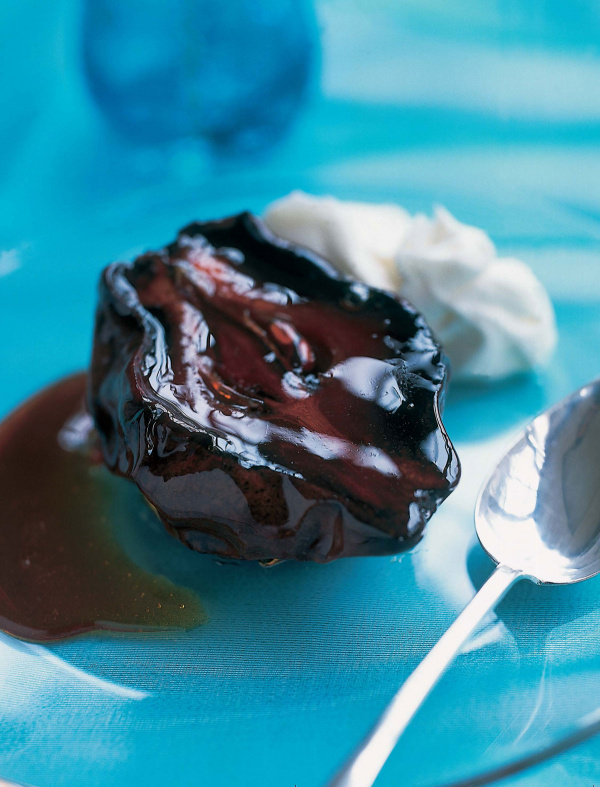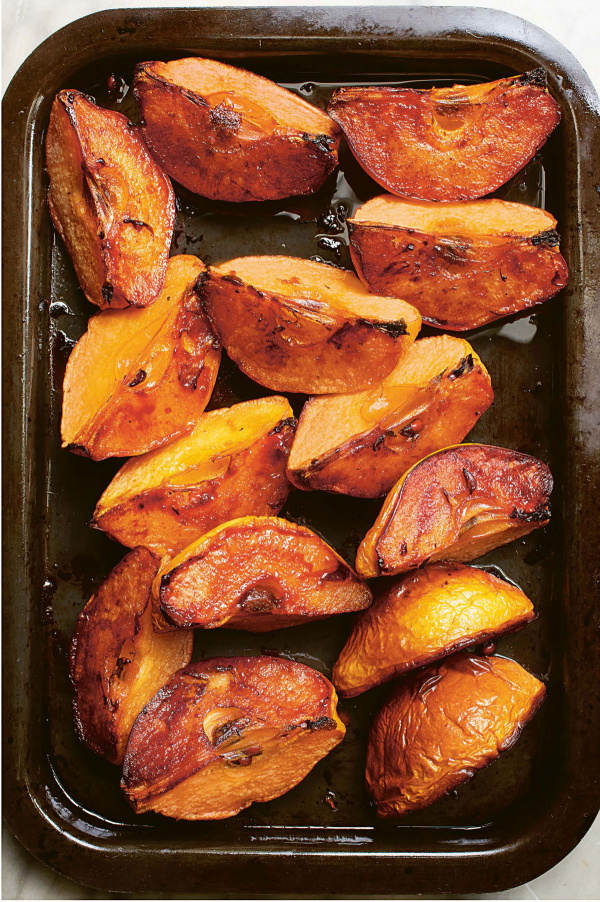Red Roast Quinces
by Nigella. Featured in NIGELLA SUMMERIntroduction
When the two great Australian food writers, Stephanie Alexander and Maggie Beer, came to London some 30 years back, I went to a dinner cooked by them; this was the pudding and I remain, all this time later, transfixed by it.
It used to be that you could never lay your hands on a quince unless you had a tree, and so it was that the first thing I did when I bought a house with a garden was plant one, though now you can come across them much more easily when they are in season in October, November and December, though you can often get lucky beyond these months. Nothing matches their almost fantastically perfumed fragrance; and after this long, slow way of cooking them, their acid flesh turns to grainy, intense honeyedness, set to coral jelly at their centre, around the shiny black pips, the whole as darkly sticky as toffee apples. Serve these warm-to-room temperature, with a dollop of cold mascarpone on the side.
Do note the long cooking time and make sure you factor that in when you plan to cook them.
When the two great Australian food writers, Stephanie Alexander and Maggie Beer, came to London some 30 years back, I went to a dinner cooked by them; this was the pudding and I remain, all this time later, transfixed by it.
It used to be that you could never lay your hands on a quince unless you had a tree, and so it was that the first thing I did when I bought a house with a garden was plant one, though now you can come across them much more easily when they are in season in October, November and December, though you can often get lucky beyond these months. Nothing matches their almost fantastically perfumed fragrance; and after this long, slow way of cooking them, their acid flesh turns to grainy, intense honeyedness, set to coral jelly at their centre, around the shiny black pips, the whole as darkly sticky as toffee apples. Serve these warm-to-room temperature, with a dollop of cold mascarpone on the side.
Do note the long cooking time and make sure you factor that in when you plan to cook them.

Share or save this
Ingredients
Serves: 8
- 1 kilogram caster sugar
- 5 quinces
- mascarpone or creme fraiche (to serve)
- 5 cups granulated sugar
- 5 quinces
- mascarpone or creme fraiche (to serve)
Method
- Put the sugar into a large, wide saucepan, cover with 1 litre/4 cups of water, swirl to help the sugar start dissolving and add one of the quinces, cut up roughly. This is about the hardest thing you’ll be doing here: it’s a very simple recipe, but quinces are pretty well as solid as rock. Use a heavy, sharp knife and proceed with caution.
- Bring quince, sugar and water to the boil and let boil away until you have a thick viscous syrup; this could take up to an hour.
- Preheat the oven to 200°C/180°C Fan/400°F and get out a roasting tin. Cut each of the remaining quinces in half, much as you would halve an avocado and put each one, cut side down in the tin. Pour over the syrup to come about 1cm/½in deep and put the quinces into the oven for an hour. Turn the oven down to 160°C/140°C Fan/325°F and cook for another 2–3 hours, basting (with the addition of more syrup if they’re drying out) and turning regularly so that they caramelise and colour on both sides.
- Remove from the oven and set aside, cut side up, so that the oven-scorched, red-glazed quinces stand in their sticky, ever-solidifying syrup as they cool. Set each half on a small plate, along with the mascarpone or crème fraîche, as you serve and eat with a teaspoon, dipping first into jellied, grainy flesh and then into the sharp, coolly contrasting cream on the side.
- Put the sugar into a large, wide saucepan, cover with 1 litre/4 cups of water, swirl to help the sugar start dissolving and add one of the quinces, cut up roughly. This is about the hardest thing you’ll be doing here: it’s a very simple recipe, but quinces are pretty well as solid as rock. Use a heavy, sharp knife and proceed with caution.
- Bring quince, sugar and water to the boil and let boil away until you have a thick viscous syrup; this could take up to an hour.
- Preheat the oven to 200°C/180°C Fan/400°F and get out a roasting tin. Cut each of the remaining quinces in half, much as you would halve an avocado and put each one, cut side down in the tin. Pour over the syrup to come about 1cm/½in deep and put the quinces into the oven for an hour. Turn the oven down to 160°C/140°C Fan/325°F and cook for another 2–3 hours, basting (with the addition of more syrup if they’re drying out) and turning regularly so that they caramelise and colour on both sides.
- Remove from the oven and set aside, cut side up, so that the oven-scorched, red-glazed quinces stand in their sticky, ever-solidifying syrup as they cool. Set each half on a small plate, along with the mascarpone or crème fraîche, as you serve and eat with a teaspoon, dipping first into jellied, grainy flesh and then into the sharp, coolly contrasting cream on the side.
Additional Information
MAKE AHEAD/STORE:
The cooked quinces should be cooled then transferred to an airtight container as quickly as possible (and within 2 hours) and refrigerated for up to 5 days. They can also be frozen in an airtight container for up to 3 months. Defrost overnight in the fridge before eating. Remove them from the fridge about 30 minutes before serving so that they are not completely fridge cold.
MAKE AHEAD/STORE:
The cooked quinces should be cooled then transferred to an airtight container as quickly as possible (and within 2 hours) and refrigerated for up to 5 days. They can also be frozen in an airtight container for up to 3 months. Defrost overnight in the fridge before eating. Remove them from the fridge about 30 minutes before serving so that they are not completely fridge cold.






Tell us what you think
Thank you {% member.data['first-name'] %}.
Explore more recipesYour comment has been submitted.